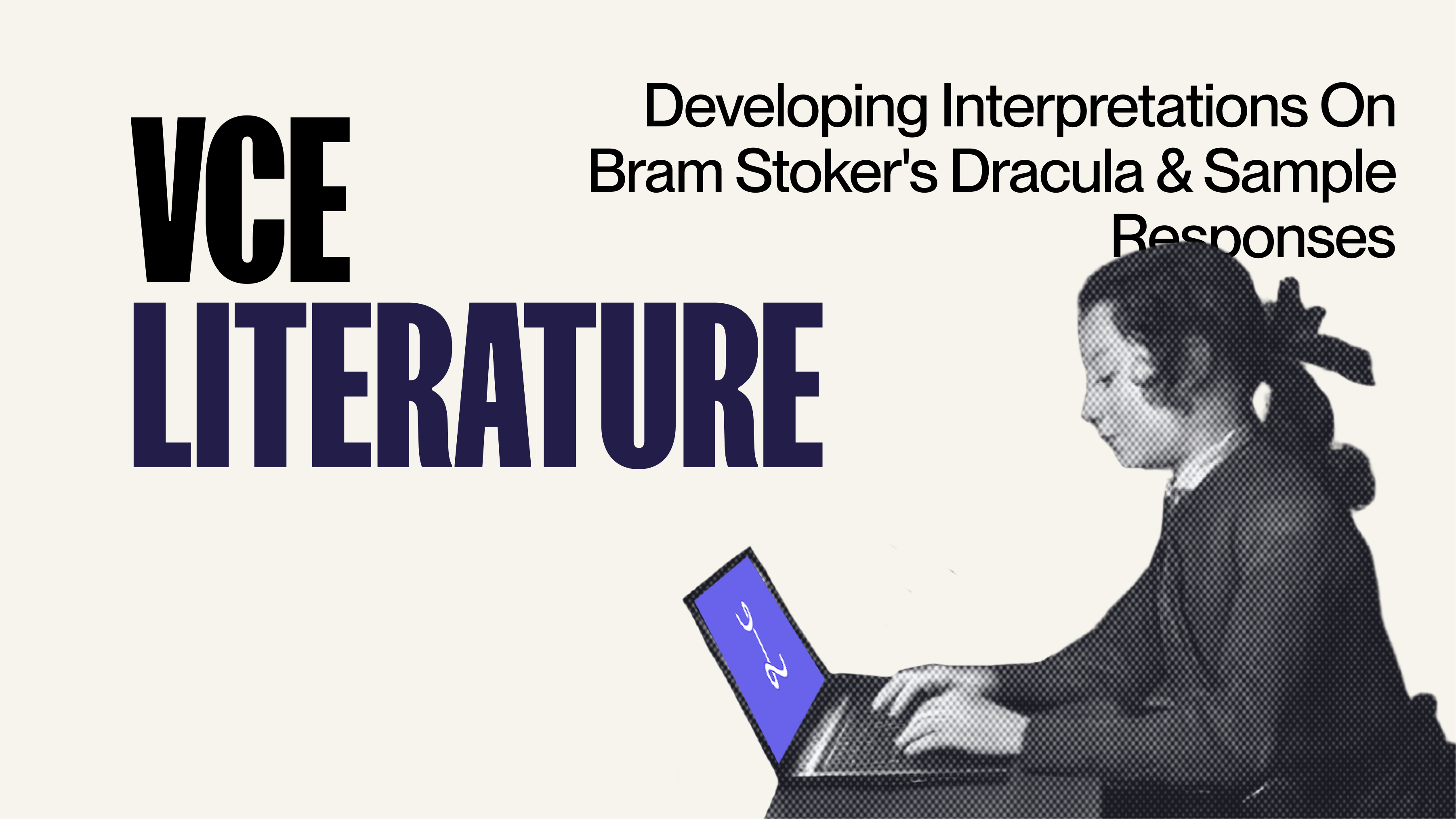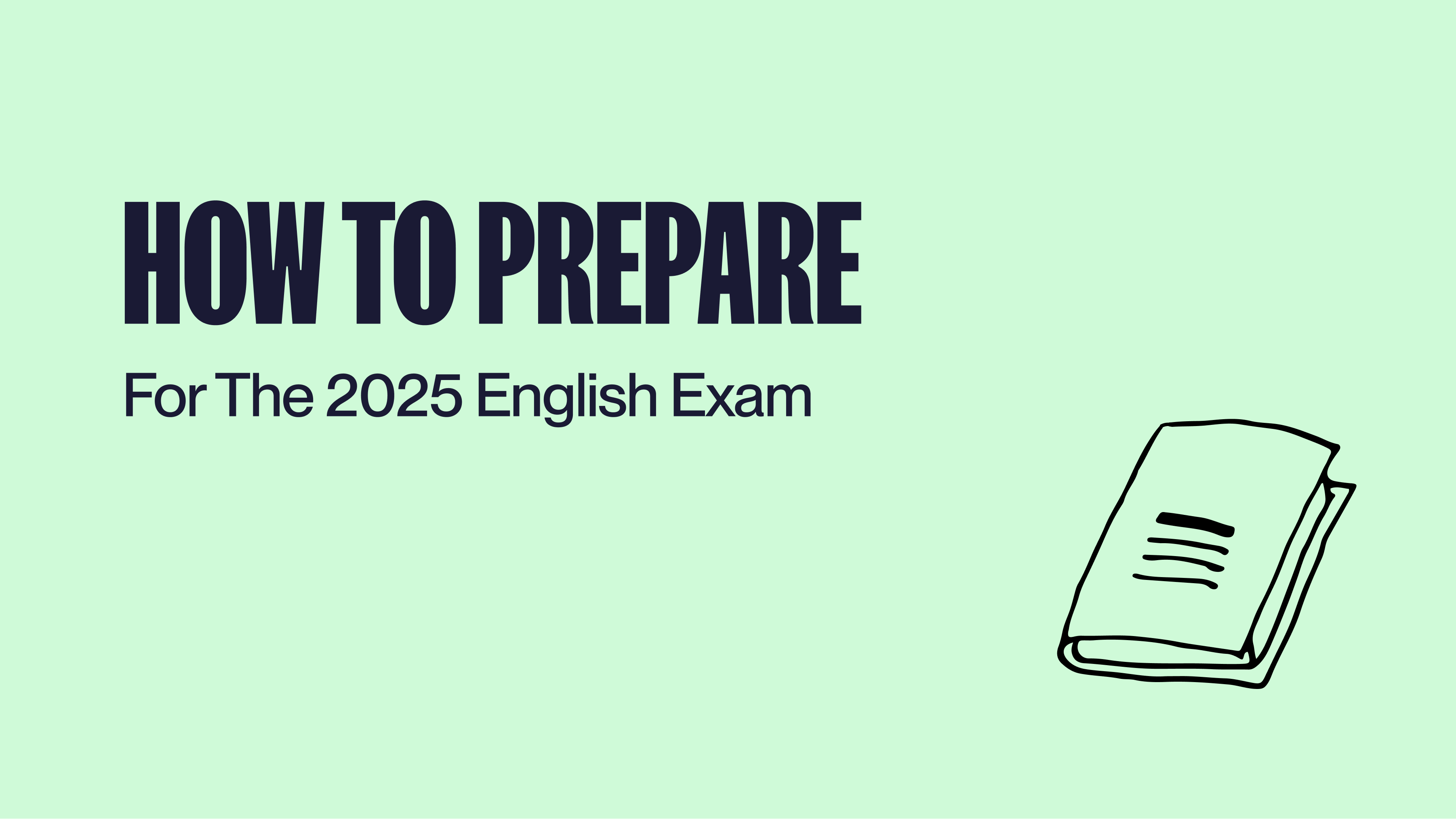
VCE Literature 2024: Developing Interpretations on Bram Stoker's Dracula & Sample Responses
Since VCAA updated the VCE literature design, there has been a lot of ambiguity as to how we should approach the ‘Developing Interpretations’, or first, component of the exam. According to the VCE Literature 2023–2027 exam specifications, Section A will require you to complete two extended-answer questions based on one set passage from one text from the VCE Literature Text List for the year in question. The first question, which is worth 6 marks, will require students to address the significance of the set passage within the context of the whole text, and Question 2, worth 14 marks, will require students to address a key concept from the text, taking into consideration both the set passage and the whole text. Easier said than done. What exactly should we do to score an A+ in this section? This blog will break down the task, specifically how can develop A+ level interpretations of Bram Stoker’s epistolary classic, Dracula.
Approaching Question 1 of Section A
Question 1 is worth 6 marks. You should spend 20 minutes on this.
Question 1 of Section A will be assessed against the following criteria:
- exploration of the significance of the set passage in the context of the whole text
- analysis of the significance of the set passage, demonstrated through the use of textual evidence
- ability to write coherently, expressively and fluently as appropriate to the task
What is the significance of the passage?
When we are given a passage from ‘Dracula’, every passage is pertinent within the context of the narrative. Whether it is merely a conversation between Mina and Van Helsing, or a climactic desecration of the eponymous Count, each section contains the following narrative devices:
Form
As an epistolary novel (meaning it takes the form of letters, diary entries, journals etc.) each passage is highly important in authentically portraying and describing the thoughts of its author. This form of writing is especially important in enhancing the immediacy of the text, and creating suspense for a Victorian readership. The plot or character, establishing scenes/sections; rising action, emotional climax, denouement etc are embellished genuinely by Stoker’s characters, affording contemporary readers an insight as to how those in Britain's fin de siecle period (turn of the 19th to 18th century), may have reacted to a situation. Always refer to the epistolary form, what has happened leading up to the passage and what may come next - within this you could focus on how Stoker’s literary techniques reinforce the significance of the passage.
Style
Either in Question 1 or 2 you must acknowledge that the passage is an example of the Gothic, employing clear genre-specific tropes which significantly add to Bram Stoker’s creation of tension, or fear or serve to echo for the reader of the Victorian era.
Setting
An analysis of the setting can significantly add to the depth of your piece! Perhaps considering what has happened previously in the passage’s location, or what will happen, can help you construct a solid argument as to why the passage is significant in the context of the novel.
Character Exposition
The passage may hold significance as it discloses a distinct facet of a character's evolution or demeanour that had remained inconspicuous until that juncture, or passage.
Concepts
Here are some concepts we see in Dracula, please note that if it is not the concept you are to write on in Question B of the exam, you should briefly refer to them if relevant:
- Feminist
- Proto-feminist
- Patriarchal
- New-historicist
- The ‘Other’
- Modernity versus Traditionalism
- British obsession with memento mori - the moment of death
- Marxist
- Psychoanalytical
Do not write on the concept focused on in Question 2 - no point doubling up!
Sample A+ response
Let's look at this in an A+ example on a passage in Chapter 17 (Where Mina Harker suffers insomnia prior to the Count’s attack):
Drawn from Chapter XVII of Bram Stoker’s fin de siècle [1] gothic classic ‘Dracula’, the passage is highly pertinent within the context of the wider novel in that it serves to foreshadow the imminent danger that The Count’s presence will hold over the vampiric transmogrification of Mina Harker. Initially, in Mina’s tone, through the anaphoric repetition of ‘I’, Stoker employs a sense of monotony, reminding his readership that it is Mina’s epistolary diary that they are reading [2]. The use of ‘I’ reiterates a sense of authenticity she has maintained throughout her journal entries. The use of a tricolon- ‘heavy, and dank, and cold’ serves as illustrative language to further render the minacious setting that is Seward’s chambers at the sanatorium [3] after the group of men leave her there while they violate the residences of The Count. Once more exploiting the Gothic metonymy of pathetic fallacy, the expository tricolon depicts the narrative setting in which Stoker reinforces a threatening locale- this language is associated with the dismal state of crypts and mausoleums, essentially hinting to Victorian readers the looming dilemma of Mina’s infection. [4] Orchestrated through an overwhelming sense of anomaly and pathetic fallacy, this triadic clause champions the pictorial nature of Stoker’s Gothic metonymy, using this language to augur the enigmatic Count’s intrusion into Mina’s room and the sequence of events to follow. [5] Notably, it is in the trichotomous reiteration of ‘red eyes’ that Stoker employs the motif of the superstitious three as he did in the tricolon. Both the eponymous Count and ‘nosferatu’ Lucy are portrayed as having eyes of ‘hell-fire’. [6 ]Distinctly, the connection between Mina’s description of the ‘light of the gas shining like a red eye’ can be comparably equated to Jonathan Harker’s note of the Count’s eyes being more ‘red in the lamplight’ upon his arrival to The Count’s residence, alike Lucy’s observation of his “gleaming red eyes” at Whitby Abbey. Here, Stoker draws on another key trope of Gothicism, with red analogously being used in texts such as ‘Jane Eyre’ to convey aggression and passion within the foreboding atmosphere of Charlotte Bronte’s text [6]. Through the contextually relevant use of Fauvism, Stoker’s illustration of Dracula’s eyes as ‘red sparks’ fortifies the notion of his vengeance. Following the men desecrating the Transylvanian coffins of Dracula, he swears to destroy something ‘precious’ to them- in this case, Mina. It is in his pursuit of penetrating Mina, Dracula implicitly demonstrates his capability and brute power in tainting the archetype of the Divine Feminine in her marital bed- through a wider prism, Dracula is instigating the ultimate attack on the group’s propriety. [7] Alluding to themes of Gothic somnambulism in this passage, Mina reflects the instability of the ‘Mad woman in the attic’ trope, claiming “last night tired me more than if I had not slept at all.”. Mina’s expression alludes audiences to recognise the dramatic irony of The Counts presence in Mina’s room the preceding night, and, once again drawing on the superstitious three, that the following night will reflect the climax of Mina’s vampirization- she is turned ‘unclean’. By virtue of Mina’s damnation that is foreshadowed through her insomnia and anxiety in this passage, the group consequently heightens their tailing of The Count, propelling the diegesis to Dracula’s escape, which allows for his ruination at the climax of the novel [8].
Approaching Question 2 of Section A
Question 2 is worth 14 marks, spend 40 minutes on this!
Question 2 of Section A will be assessed against the following criteria:
- understanding of the ideas, views and values that arise from the concept identified in the question
- analysis of the ways in which the concept identified in the question is represented in the set passage and the whole text, demonstrated through the use of textual evidence
- exploration of how the relevant ideas, views and values of the text can be endorsed, challenged and/or marginalised
- ability to write coherently, expressively and fluently as appropriate to the task
How to explore and analyse the concept identified?
This inquiry prompts you to concentrate on a specific predetermined concept, utilising the passage as the foundation for a detailed examination that extends into the broader text.
It is imperative to discern the qualitative nature of this question, where you must assess whether the content of the passage either: endorses, challenges and/or marginalises the specified concept. Make sure your examiner knows whether you think the passage endorses, challenges or marginalises the concept!
Endorses - The passage strongly reinforces the focal concept.
Challenges - It may present an opposing viewpoint. For instance, if the concept is ‘Masculinity,' the passage could involve a Journal entry from an imprisoned, helpless Jonathan Harker challenging the notion.
Marginalises - Despite referencing a concept, the passage predominantly emphasises another aspect, diminishing the significance of the specified concept.
When delving into the concept, revisit and flesh out the focus areas outlined in Part A, however the key difference is that you can use the passage to springboard to any other moment in Dracula. Use this as a chance to show off your intratextual knowledge - use quotes and refer to recurring motifs to support your points.
Any unaddressed contextual references, or unexplored aspects of form and style, can be incorporated into Question 2 if they contribute to the discussion and support your arguments!
Sample A+ response
Here is a sample response to question two, with the concept of ‘propriety’:
Published in 1897, Bram Stoker’s epistolary classic ‘Dracula’ exemplifies the expectation of propriety within 19th century Victorian Society, [1] most notably through its pious rendering of Mina Harker. Highlighting the relevance of sanity within Victorian readership, Stoker reveals Mina’s “anxiety” within the opening sequence of the passage. Only done through her intimate journal, such as when she prepares for Van Helsing’s arrival earlier to this passage, Mina similarly admits a sense of ‘powerlessness’. It is in her divulgence of vulnerability [2] that Mina is portrayed as the paramountcy of a persecuted maiden- “anxiety” ridden and “waiting for Jonathan to come back”, with her reliance on male spouses being a plausible trait of women in Victorian society. Rivalling the sexually liberated ‘New Woman’, Stoker includes Mina’s reliance on Jonathan to reinforce the paragon of desired feminism [3], where Mina may still be sheltered from the gore of hunting The Count.[3] Mina maintains this whilst still having a “man brain” and subsequently proving herself capable of complex cognitive processes that were not typical of the Gothic heroine- remembering train times and translating shorthand. Through a wider lens, this highlights the degrees of tolerable progression of feminism. Succubi such as Lucy and the vampiresses are dehumanised for their sexual endeavours, being reduced to “a thing” to be mutilated. Through syndetic listing, Stokers tricolon [4] of “my feet, and my hands, and my brain” reinforces Mina as being grounded, opting to mundanely describe her androgynous limbs, instead vouching her femininity through her actions of missing Harker. This is done by Stoker’s formulation of Mina, rather than through Mina’s figure to separate his paradigm of domestic divinity from the “voluptuous” silhouettes of the other women of the text, whose objectification mimics the societal condoning of sexual liberation in women. This ensures to depict Mina as an archetype of the desirable ‘New Woman’, whose progressiveness allows for no disruption to the patriarchy or execution of womanly duties of caring for the family. Drawing on themes of oneiromancy, Stoker delineates the challenging of Mina’s sanity in her second night of isolation. ‘Laden lethargy’ plagues her- careful liquid alliteration ensuring to mimic the effect of a lullaby- a motif of restful sleep and innocence. However, her toil with achieving adequate rest reflects the wider gothic trope of sleep disturbance. A testament to La Sonnambula, an 1831 Italian opera composed by Vincenzo Bellini, of which Stoker was aware of, it recounts its female protagonist’s, Amina’s, consequences of disturbed sleep. Initially framed as engaging in adultery with a Count, Amina ultimately is recognised as a faithful wife and continues her engagement. Correspondingly in both name- Mina, and plot, Mina being deemed a “monster” after she is bitten by The Count, both characters are fundamentally accepted as ‘angels of the hearth’. Amid this correlation Stoker depicts Mina as a wider archetype of the ‘Madonna’, whose purity may mistakenly be questioned , however is at her core the quintessence of fidelity. As a Victorian contemporary [5], his novel addresses even greater social relevance as this auto-erotic dream sequence of The Count’s infiltration into the marital bed of Mina embodies the same sexually repressed emotions represented in the oneiric lust of Harker in Chapter III. The “wicked burning desire” Harker acknowledges positions women who lack moral propriety as being an almost unavoidable temptation. It is significant that Stoker deliberately positions Harker as being a passive victim of this assault; he is “reclining” and the vampiress is “bent over” him in a dominant posture, alike the phallic symbol of Dracula as “pillar” and “white face bending over [her] out of the mist”. This personification of the penetrative fog both insinuates the perversive percolation of The Count- a symbol of repressed sexuality in Victorian Society. Superlative description of the fog growing “thicker and thicker” and entering through the joins of the door rather than the door or a window enforces the presumption of syphilis inadvertently spreading in Victorian society before the discovery of it being sexually transmitted [6]- significant transmission occurred as the 19th century entailed the highest percentile of brothels per capita in all British history. Similarly, Mina, an unbeknownst prey to the same “undead” threat, believing to have “fainted”, she embodies the same alleviation of guilt due to her naivety in suspecting The Count as the catalyst of her “lethargy”. Stoker’s authorial direction to render Mina in an innocent light reiterates her decorum- not consciously seeking sexual gratification of Dracula, rather she is “weighted” into submitting to it. Mina’s sexuality remains enigmatic throughout the whole of Dracula. Though she marries, she never gives voice to anything resembling a sexual desire or impulse, which enables her to retain her purity. Stoker’s favourable depiction of both protagonist, Harker and heroine, Mina as unwilling victims of the vampire’s penetration endorses them as archetypes of the ideal central characters, whose propriety ultimately allows for the denouement of a seemingly gratifying life together with a child. Though resourceful and intelligent enough to conduct the research that leads Van Helsing’s crew to the count, Mina is far from a “New Woman” herself. Rather, the lattermost chronicle of Mina reduces her as an archetype of divine femininity- she is a dutiful wife and mother, and her successes are always in the service of the patriarchy. Mina’s moral perfection remains as stainless, in the end, as her forehead [7].



